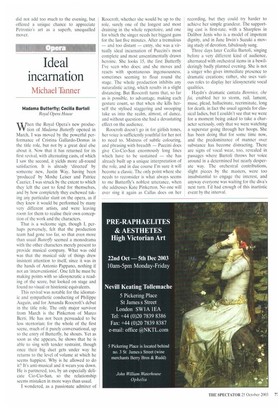Mesmerising exoticism
Giannandrea Poesio
La Bayadere Royal Ballet Royal Opera House Rosas Sadler's Wells Stephen Petronio Company Queen Elizabeth Hall
Pere is no better way to start a new batet season than by kicking off with a spectacular, glitzy crowd-pleaser. Natalia Makarova's production of Marius Petipa's 1877 ballet La Bayadere might not have the dashing splendour of Rudolf Nureyev's staging for the Paris-Opera or the philological richness of the recently 're-discovered' Kirov version, but it still retains all the 'known' virtuoso bits that drive most bal letomanes crazy, as well as an utterly enjoyable passe. atmosphere. To propose it for the opening of the 2003/04 Royal Ballet season was thus a clever move, as demonstrated by the delirious ovations that punctuated the first night. And, on the whole, it was an enjoyable evening, even though not everything was exactly hunky-dory.
Carlos Acosta as the love-tormented hero was simply sensational, tackling the virtuosity the part calls for and mesmerising the audience with all the possible tricks of the trade, including some breathtakingly long-held poses at the end of tornado-like pirouettes. As the evil princess Gamzatti, Marianela Nufies, too, gave a superb performance, combining diamond-sharp technique with a dramatic rendition that made totally credible, and even irresistibly seductive, her stereotypical ballet-villainess role. Nunes is a dancer who has a profound understanding of the 19th-century style, and it will be interesting to see her as the female protagonist of the same ballet in one of the forthcoming performances.
Tamara Rojo, as the ballet's unhappy heroine, is another dancer capable of mastering the demands of the Petipa style. I only wish she could be a more convincing actress. On the opening night, her technique was not at its usual best, and suffered from a jerky approach to the legato passages. Worst of all was her inconsistent control of the classical lines demanded by the choreography, mostly evident in the wonky arabesques she displayed throughout the celebrated 'Kingdom of the Shades' act. •The awkward line of Rojo's backwardly extended leg was little or nothing compared to the shameless disregard of Petipa's classical canons which inform the solo dancing of each of the three main 'Shades' in the same act. Luckily, the rest of the corps danced fairly competently, even though one could spot here and there some wobbly balances, some badly developed developpees, and some not-alwaysstraight lines.
For those allergic to the preposterous balletic exoticism of La Bayadere, the 25th Dance Umbrella season keeps offering an overwhelming number of worthy alternatives. At Sadler's Wells I spent a truly ntense evening in the company of Rosas. director Anne Teresa de Keersmaeker and dancer Cynthia Loemij, who were engaged in a 70-minute-long duet, Small Hands (out of the lie of no), set to music by Purcell. As usual with Keersmaeker's works, unpredictability is the core component of this work, for the duet vibrates from the very first moment to the last with a crescendo of emotions, without ever reaching a final deflagration or a much-awaited denouement. The lack of a final explosion, however, is what enhances the drama of the piece, danced in the round by the two interpreters amidst a well-devised combination of repetitions, pauses, and brief interactions with objects that delineate their space.
At first, Small Hands can be seen as a nostalgic look at the early days of European Postmodernism, when running and other pedestrian activities were utterly provocative. Yet, this work is anything but a nostalgic adaptation of déjà-vu formulae, and shows clearly Keersmaeker's ability to rework the past to achieve something new.
Stephen Petronio, too, still has a lot to say, at least according to what I saw at the Queen Elizabeth Hall last Saturday. Surrounded by dancers to die for, he appears in The Island of Misfit Toys as a gothic figure, namely, a sort of nightmare master who silently directs and watches the frenzied and frantic actions of his dancers, clad in colourful nighties and pyjamas. Appropriate aural references to Edgar Allan Poe accompany in the first half an amazing display of technical bravura. Yet by the time the dancers move to songs by Lou Reed the dance loses momentum and becomes too long, something that happens also in the last item on the programme, the 2002 City of Twist. Still, the architecturally superb construction of solos, duos and ensembles makes one forget the one or two moments during which the action drags. Squeezed in-between, Broken Man did not add too much to the evening, but offered a unique chance to appreciate Petronin's art as a superb, unequalled mover.



































































































 Previous page
Previous page